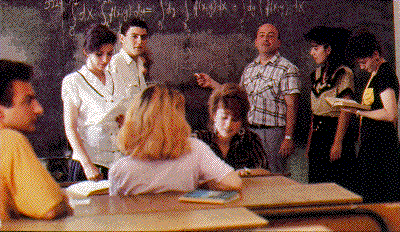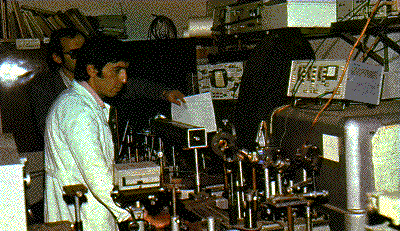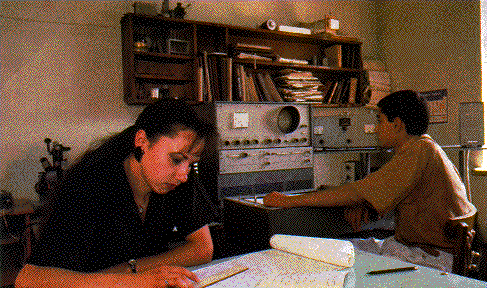Faculties (2)
Faculty of Mechanics
This Faculty has two departments; mechanics of continuous media; and theoretical mechanics. There are associated academic laboratories. Students, having
completed basic courses in mechanics and mathematics, continue their studies in the following  specializations: theory of elasticity, plasticity and strength, fluid
mechanics, mechanics of natural processes; management of mechanical systems; theory of
robotics and manipulation. Graduates are certified as applied mechanical engineers and
teachers. They work in research institutes and in schools and institutions of higher learning.
The best students go on to do graduate work.
specializations: theory of elasticity, plasticity and strength, fluid
mechanics, mechanics of natural processes; management of mechanical systems; theory of
robotics and manipulation. Graduates are certified as applied mechanical engineers and
teachers. They work in research institutes and in schools and institutions of higher learning.
The best students go on to do graduate work.
The significant scientific achievements of the Faculty have helped give the Armenian school
of mechanics an international reputation. Achievements in the fields of the mathematical
theory of elasticity, the mechanical theory of non-isotropic non-homogeneous media and
magnetoelasticity have greatly enriched modern science. Research is conducted in various
areas of mechanics, especially in the theory of elasticity of non-isotropic bodies, problems
of contact, the theory of plastines and membranes, magnoelasticity, hydrodynamics,
optimization of mechanical systems, control of motion and stabilization, differentials and
theory of manipulators. Mechanical engineers play an important role in the creation of new
theoretical foundations for technological progress in the Republic.
Faculty of Physics
The Faculty has ten departments which offer training in 16 specializations. Certain departments and laboratories of the Faculty of Physics served as the basis
for the founding of the Faculty of Radiophysics in 1975 and the Lazerayin Tekhnika Research and Production Facility in 1978.
 The Faculty offers a five-year course of study. During the first three years, courses
provide a basic education in physics and mathematics. Beginning with the third year,
students begin the study of their chosen specialization.
The Faculty offers a five-year course of study. During the first three years, courses
provide a basic education in physics and mathematics. Beginning with the third year,
students begin the study of their chosen specialization.
Specializations include theoretical physics, mathematical physics, modeling of physical
phenomena, astrophysics, nuclear physics, optics, optoelectronics, solid state physics,
high temperature superconductivity, X-ray crystalophysics, macromolecular physics,
quantum electronics, growth of crystals, physics of biopolymers, automation of physics
experiments, and plasma physics.
Graduates receive an education equivalent to that of a Master's degree from one of the
world's foremost universities.
The Faculty's various departments have received world-wide recognition for their scientific work, especially in the fields of super-dense celestial bodies,
non-linear optics of statistically ungovernable media, the dependence of solid-state (crystals, membranes, etc.) physical qualities on the quality of crystal
networks. The Faculty actively participate in international scientific and academic programs.
Faculty of Radiophysics
This Faculty has the following departments: super-high frequency radiophysics; quantum radiophysics, semiconductors and dielectrodes; wave theory; and
higher mathematics. It also has a laboratory for research on semiconductor materials and instruments.
 Academic programs include a complement of basic, specialized and
applied courses. Initially students are trained in two areas: (i) radiophysics
and electronics; and (ii) the physics of electronic equipment materials and
components (the physics of semiconductors and dielectrodes). Starting in
the third year, students can choose to specialize in super-high frequency
radiophysics, laser physics and technology, electrodynamics and the
broadcast of radio waves, and microelectronics.
Academic programs include a complement of basic, specialized and
applied courses. Initially students are trained in two areas: (i) radiophysics
and electronics; and (ii) the physics of electronic equipment materials and
components (the physics of semiconductors and dielectrodes). Starting in
the third year, students can choose to specialize in super-high frequency
radiophysics, laser physics and technology, electrodynamics and the
broadcast of radio waves, and microelectronics.
The Faculty conducts research in the reception and amplification of weak
super-high frequency signals, their interaction with electromagnetic waves,
electron-wave interaction, the physics of semiconductors, solar energy
transformers, high-temperature superconductor ceramic materials, theory
of super-dense celestial bodies, and the theory of functions.
Graduates of the Faculty are certified as radiophysicists and physicist-engineers and can be employed in relevant research institutes, institutions of higher
education as well as in the radioelectronics industry.



This page created by Internet Telepresence Inc. 1996.
E-Mail at sales@itgateway.com
 specializations: theory of elasticity, plasticity and strength, fluid
mechanics, mechanics of natural processes; management of mechanical systems; theory of
robotics and manipulation. Graduates are certified as applied mechanical engineers and
teachers. They work in research institutes and in schools and institutions of higher learning.
The best students go on to do graduate work.
specializations: theory of elasticity, plasticity and strength, fluid
mechanics, mechanics of natural processes; management of mechanical systems; theory of
robotics and manipulation. Graduates are certified as applied mechanical engineers and
teachers. They work in research institutes and in schools and institutions of higher learning.
The best students go on to do graduate work. The Faculty offers a five-year course of study. During the first three years, courses
provide a basic education in physics and mathematics. Beginning with the third year,
students begin the study of their chosen specialization.
The Faculty offers a five-year course of study. During the first three years, courses
provide a basic education in physics and mathematics. Beginning with the third year,
students begin the study of their chosen specialization. Academic programs include a complement of basic, specialized and
applied courses. Initially students are trained in two areas: (i) radiophysics
and electronics; and (ii) the physics of electronic equipment materials and
components (the physics of semiconductors and dielectrodes). Starting in
the third year, students can choose to specialize in super-high frequency
radiophysics, laser physics and technology, electrodynamics and the
broadcast of radio waves, and microelectronics.
Academic programs include a complement of basic, specialized and
applied courses. Initially students are trained in two areas: (i) radiophysics
and electronics; and (ii) the physics of electronic equipment materials and
components (the physics of semiconductors and dielectrodes). Starting in
the third year, students can choose to specialize in super-high frequency
radiophysics, laser physics and technology, electrodynamics and the
broadcast of radio waves, and microelectronics.